Bathroom and Toilet Design
Efficient Bathroom and Toilet Floor Layout Plans and Design
Once we have planned what we need in our bathroom we can set about working out a floor plan thats suits what we want and within the amount of space available.
Here we look at the dimensions of standard bathroom items and how we can cleverly design a bathroom to make the best use of space available, floor plans that give us workable and efficient bathrooms and toilets.
See also:
We All Like A Well Designed Bathroom
A well designed bathroom helps us start the day. Some weeks ago we started looking at bathroom design, let us continue this week by looking at layout. A bathroom is essentially a functional space and needs some thought, mistakes might drive you mad for years to come.
The basic four features of a bathroom
Most bathrooms incorporate 4 basic components in their design, a place to wash your body (a bath or shower); a place to evacuate your bowel and/or bladder; a place to scrape your face, brush your teeth, put on your warpaint and squeeze the odd blackhead or two (washbasin or vanity) and, of course, a way of getting in or out of the room (usually a door though anything is possible when architects are searching for new design ideas to make them stand out from the crowd).
There are other components of course such as towel rails, naughty bit washers, mirrors, soap holders, toilet roll holders, bathroom cabinets, wastebins, a magazine rack next to the toilet and, for those who are designing a restroom, the odd bed or two. These are secondary issues that follow the placement of the basic four components.
It all sounds quite simple really but if you start looking at bathroom layouts you will start to realise just how many permutations there are. You will also realise that size is important especially if you are adding a new bathroom into an existing house.
Fitting a bathroom into a small space
Working in a small space you will very quickly realise that the swing of the door is an important consideration. The problem can be made easier by reducing the width of the door itself. A full sized door is normally about 90cms wide but for a bathroom this can be reduced to 80 cms without being noticed and even down to 70 cms and still be functional without looking too spartan (I suspect that most Spartans can't afford bathrooms these days). Any less and your house starts to take on the cosy "circus caravan" look.
It doesn't sound like much but a 20cm difference in the radius of the sweep of the door makes a huge difference in terms of the space lost just trying to get the flipping door open. To save even more space you could use a sliding door or you could make the bathroom door swing outwards rather than into the bathroom leaving you with a look that might be appealing to Roger the Cabin Boy.
While mentioning the door another important consideration is the line of sight as you open it. I recently found myself in a hotel room in which, if the room curtains were open and the bathroom door half open, someone bringing breakfast to the door could get a clear view of the occupant sitting on the tut. It is a good idea to try and keep the toilet out of sight when the door is opened.
Standard sizes of bathroom and toilet fixtures and fittings
The shower is the next large item to put into your bathroom. A good size for a shower is 1 metre by 1 metre. 90cms by 90 cms is starting to look "space efficient" while an ultra compact shower can be down to 75 cms by 75 cms. A bit of experimenting and you will soon find that for a fairly square bathroom the shower will end up diagonally opposite the door.
A standard toilet is about 40 cms wide and 60 cms deep and for comfort you need a minimum space of say 80 cms wide too allow a bit of elbow space.
A standard washbasin is about 60 cms wide and 50cms deep which will need a minimum of say 10cms elbow room on each side. For even smaller spaces you can use a small hand basin. Be careful, those small corner washbasins take up a lot less space but are rather cramped for everyday use while the small wall mounted ones are really useful for washing hamsters.
While we are talking about washbasins don?t be tempted to put a shelf on the wall immediately above the washbasin and under the mirror. You may see this a lot in local bathrooms. For some reason the person placing the shelf has not realised that shaving or cleaning your teeth becomes an obstacle course with that shelf in the way. The hazard becomes a little scary when the shelf is glass (which they usually are).
So we place the washbasin and toilet in the other two corners and we end up with a standard bathroom, compact but fully functional.
A standard compact bathroom for a small space
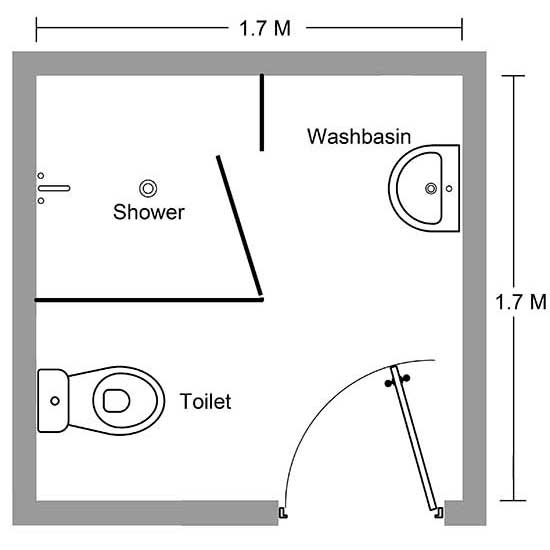
You might wish to use a vanity rather than a washbasin.
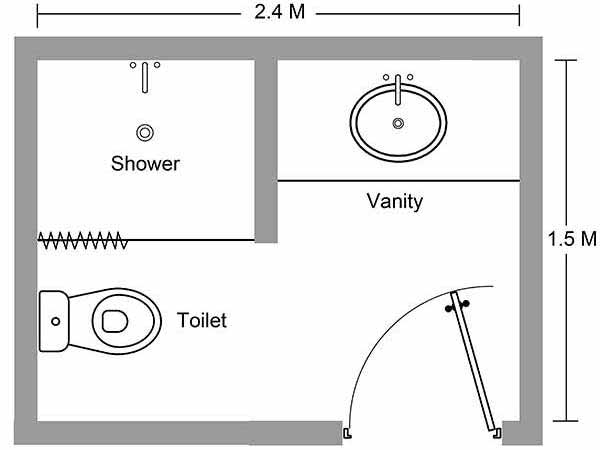
A very compact bathroom
If you want a very compact bathroom. Use a curtain rather than a screen for the shower to allow the shower to encroach into the washbasin and toilet elbow space. You will also need to use a narrow door.
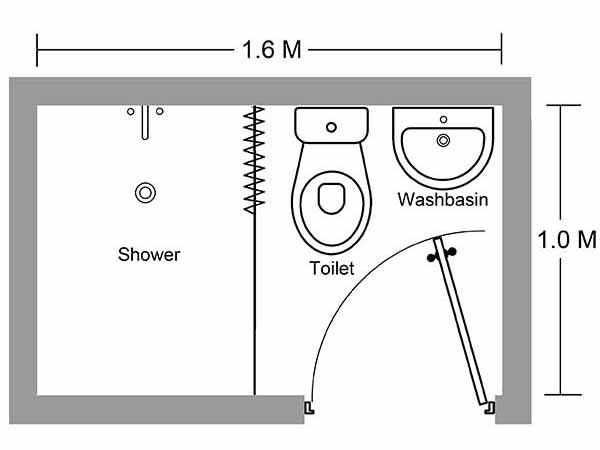
Typical hotel bathroom
Room layouts used in hotels have developed over many years and bathroom design has been refined down to a fine art. Hotel bathrooms tend to be very functional and, while they are designed to be space efficient, they can still have enough space to feel luxurious. The only common problem is the use of the bath for the shower. Most follow the same standard layout as follows:
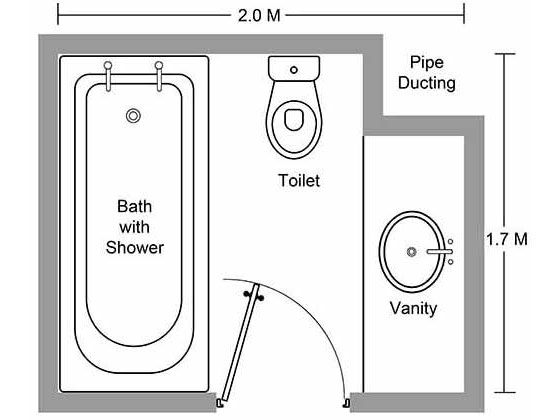
A More Efficient hotel bathroom
In recent years hotels are starting to dispense with space hogging baths leading to more efficient bathroom layouts. Here is one I came across recently that is compact but works well.
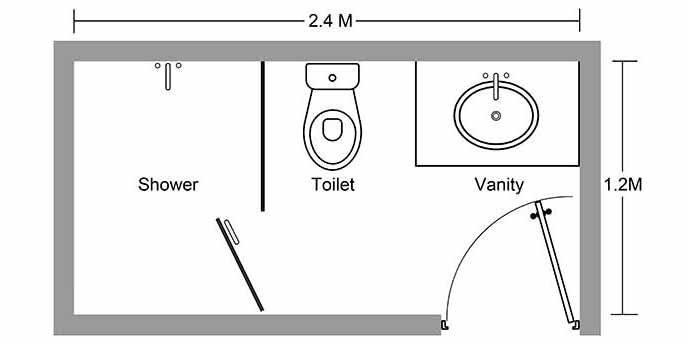
Luxury Bathrooms
Small bathrooms can still look luxurious by using well chosen high quality tiling and fittings but to really look more luxurious you need to add more space.
The shower, for instance, can be increased to a minimum size of 1 metre by 1metre. The washbasin will be replaced with a vanity which should be around 55 to 60 cms deep and a minimum of say 1.2 or 1.3 metres wide to give you space for all those knick knacks that seem to collect over time. Don?t go mad, you need to be able to comfortably reach your toothbrushes at the back?
The height of a vanity is good at about 85 cms (a little lower than the 90cms for a kitchen benchtop). For small Indonesian people lower the height by say 5 cms.
Do you need a bath?
Many will wish to add the luxury of a bath to their bathroom and a normal sized bath is about 170 cms long by 70 cms wide. Try and avoid large terrazzo baths unless you have a water heater the size of Petrol tanker. You might want to think twice about the bath. It's a nice idea but how often will you actually use it?
Bathrooms tend to be functional spaces and most people follow very set routines. Designing your own bathroom is not difficult. Draw a plan and start shuffling around the major elements until you find something that works for you and your household.
Think ergonomically, design the space to suit the way we huperson beings live our lives, we need space to rub our selves with a towel. The toilet roll should be within easy reach of a seated client, a mirror needs to be well placed and lit to enable those blackheads to be located and dealt with. If in doubt go and have a look at other people's bathrooms and take your tape measure to the toilet with you.
See also:
Phil Wilson
Copyright © Phil Wilson July 2013
This article, or any part of it, cannot be copied or reproduced without permission from the copyright owner.
